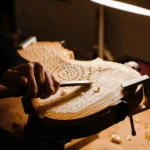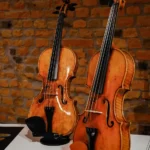Your Violin Setup: How to Pick The Right Accessories
Back to BlogThere is a lot that comes with playing the violin, the practice, dedication, the music, and understanding of your instrument: the Violin Setup! Learning about the violin accessories will allow you to choose the proper fitting, and consequently, you will get a better violin for you.
The process of setting up a stringed instrument is crucial to your performance and enjoyment. As the final step in making any violin, it includes: carving the bridge, the chinrest, tailpiece, pegs and nut, fingerboard, and setting the strings.
All these factors, in the end, make your violin sound and playability better. You will probably hear the difference if a violin is poorly set up. However, you can always fix and change the fittings, so it is possible to change an instrument entirely just by making a few adjustments.
A Violin Setup is the one responsible for closing the violin construction.
One of the most important things you can do when trying to get better as a musician is to invest in a good violin setup; high-quality fittings can be the turning point here. Not only will your violin sound better, but it will also be easier to play if it is well set up.
Another advantage is your growth in music. You will notice that when everything is suitable with your violin, you learn faster, enjoy your playing more, and you can feel the stability. Just as important, you must be aware that they should fit your violinist’s goals, there’s no point investing in a specific item if you won’t be needing it when you play.
The main fittings of your violin
Ideally, a peg would fit perfectly into a hole and turn easily. Unfortunately, it’s expected that the wood often distorts under the cutter as it is being machined, and when the cutter is removed, it springs back, leaving a taper that is not entirely accurate. Choosing the right material and a good peg will make things easier for you.
The fingerboard provides much of the strength for the neck assembly. The top of the fingerboard is curved across it and dish-shaped when looked at from its side. Both of these features help a player stop a string and prevent a buzzing string by stopping it from touching the fingerboard in inappropriate places.
The soundpost is the most mysterious part of the violin because its purpose is easy to understand but putting it in place can be difficult. The soundpost is a short length of pine dowel that fits between the top plate or table and the backplate inside the violin. Small but powerful, it is also known as the violin’s soul.
The soundpost should be positioned between the top and back plates of the violin and wedged tightly in place. It is not glued but just held in place by pressure from the strings on the bridge and by the bridge itself.
The nut is situated near the pegs at the end of the neck of the violin. The purpose of this piece of ebony is to support the strings, keep them apart and at the correct height, and guide them to their respective pegs.
Found at the end of the violin body, there is the end button, another critical piece! The modern violin’s tailpiece attaches to the bottom of its tail gut at the end and loops around the end button. This provides a sturdy anchor point to hold the tailpiece in place.
It seems a lot, but it’s worth learning about violin setup; after all, this will help you improve, and as a result, you will be more motivated.
A violin is already a beautiful musical instrument, but having a good set of fittings is essential so you can maximize your violin playing experience. Every violinist knows that naturally, it’s not very comfortable to play this instrument, and this is the way to make it easier and as comfortable as possible.
The violin is not a naturally comfortable instrument to play, but there are some ways to make it as comfortable as possible. Your individual combination of chin rest and shoulder rest can help a great deal. When deciding what to use, consider the shape of your shoulders, the length of your neck, and even the shape of your jawbone. There are many kinds of chin rests and shoulder rests, and your combination of the two is often referred to as your set-up.
Take into consideration your body shape, the length of your neck, your shoulders shape, arm length, the shape of your jawbone, etc. Like when deciding on the combination of a chinrest and a shoulder rest, there is an infinity of these fittings on the market. Think like this once the setup is perfect for you, there is nothing else to think about but your music. You won’t lose focus.









